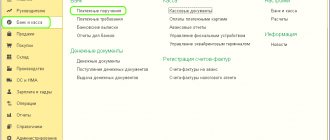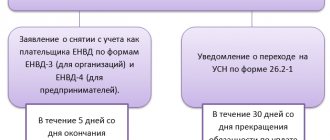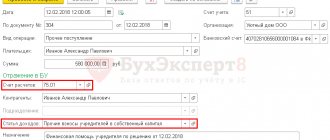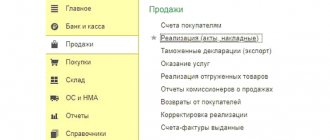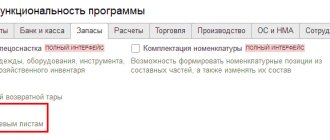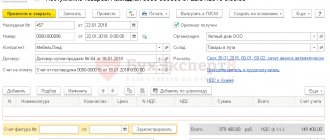Requirements for OS accounting registers
Registration of OS accounting registers occurs in compliance with uniform requirements for the creation of these documents. Accounting registers are consolidated forms for displaying accounting data, formed on the basis of information contained in primary documents (clause 19 of Order of the Ministry of Finance of the Russian Federation dated July 29, 1998 No. 34n). As a rule, they are formed so that each of them reflects a group of homogeneous information that falls into a certain accounting account (for example, about fixed assets, about capital investments, about inventories or about calculations). The use of this document is mandatory for all persons conducting accounting in Russia (Article 2 of the Law of the Russian Federation “On Accounting” dated December 6, 2011 No. 402-FZ).
The fundamental requirements for registers are contained in Art. 10 of the same law:
- The data included in them must be shown in accounting in a timely manner (clause 1) without any distortion (clause 2).
- Information in registers is reflected in the double entry method, unless the possibility of using a different method is established by law (clause 3).
- If there are details required for this document (clause 4), the forms of the applied registers are developed and approved by the person in which the accounting is maintained (clause 5), attaching them to its accounting policies. An exception is public sector organizations that are required to use the forms approved for them by Order of the Ministry of Finance of Russia dated March 30, 2015 No. 52n.
- Registers can exist both on paper and in electronic form (clause 6). To transfer them at the request of other persons, the electronic document is transferred to paper (clause 7). At the same time, corrections in them that are not agreed upon with the person responsible for maintaining the registers are not allowed (clause 8).
- In its meaning, the register is equivalent to an accounting document (clause 9).
The required details for the register include:
- the name of the register and the person in which this register is used;
- the period for which the register is compiled or its start/end dates;
- principle of formation: chronological or systemic;
- quantitative accounting indicators indicating the units in which they are expressed;
- signatures of responsible persons containing their transcript and indication of position.
All these rules are directly related to OS accounting registers.
For more information about existing types of accounting registers and their application for certain accounting data, read the material “Accounting registers (forms, samples)”.
Settings…
... functionality and accounting parameters
To account for transactions with fixed assets, you must enable the appropriate program functionality. In the Functionality form (Main - Settings - Functionality) on the OS and intangible assets tab, set the Fixed Assets flag. In this case, the OS and intangible assets section appears in the section panel, where the user gets access to all operations with fixed assets that are supported in 1C: Accounting 8 (rev. 3.0).
Accounting for the costs of purchasing finished fixed assets is carried out not only in monetary terms, but also in physical terms. Depending on the program settings, you can organize additional accounting for warehouses (in quantitative or quantitative-cumulative terms).
This feature is installed in the program before starting accounting in the Inventory accounting form (Fig. 1), which is accessed from the Administration section (Accounting parameters - Setting up a chart of accounts - By item, batches and warehouses (by quantity and amount)).
Rice. 1. Setting up inventory accounting
Additionally, you can enable accounting of material assets (including equipment for installation and non-current assets) by batch, that is, various documents that record the receipt of these assets at the warehouse.
Inventory settings are also available directly from the Chart of Accounts (Main section) using the Chart of Accounts settings hyperlink.
...accounting policy
When starting accounting in the program, you should decide on the accounting policy of the organization. For fixed assets, it is necessary to indicate the depreciation calculation method in accounting and tax accounting.
In accounting, depreciation of fixed assets can be calculated in one of the following ways (clause 18 of PBU 6/01, approved by order of the Ministry of Finance of Russia dated March 30, 2001 No. 26n):
- linear method;
- reducing balance method;
- method of writing off value by the sum of the numbers of years of useful life;
- method of writing off cost in proportion to the volume of products (works).
In this case, the use of one of the methods of calculating depreciation for a group of homogeneous fixed assets is carried out throughout the entire useful life of the objects included in this group. It means that:
- organizations can apply different methods of calculating depreciation to different groups of fixed assets;
- The method of calculating depreciation applied to a specific fixed asset cannot be reviewed or changed.
That is why in “1C: Accounting 8” the method of calculating depreciation in accounting is indicated in relation to a specific fixed asset object (a group of similar objects) when accepting it (them) for accounting. In the information register Accounting Policy (section Main), where the key parameters of the accounting policy are established, the method of calculating depreciation is not named. At the same time, in the printed form of the Accounting Policy for Accounting, by default it is stated that to calculate depreciation of fixed assets, the linear method is used for all fixed assets. If the organization uses other methods of calculating depreciation, then they must be indicated in printed form by editing the proposed file.
For profit tax purposes, depreciation can be calculated using the linear or non-linear method (Article 259 of the Tax Code of the Russian Federation), in this case:
- the method of calculating depreciation is established by the taxpayer independently in relation to all objects of depreciable property and is reflected in the accounting policy for tax purposes;
- from the beginning of the year, you can change the method of calculating depreciation, which will apply to all fixed assets and intangible assets, regardless of the date of their acquisition (from the non-linear method to the linear method it is allowed to switch no more than once every 5 years).
In “1C: Accounting 8” (rev. 3.0), the selected depreciation method is indicated in the form of income tax settings (Main - Taxes and reports - Income tax).
Please note that for depreciable property included in depreciation groups 8-10, the linear method is always used, regardless of the accounting policy settings (clause 3 of Article 259 of the Tax Code of the Russian Federation).
… tax accounting of fixed assets
Tax accounting of individual fixed assets has its own peculiarities. To reflect information about state registration and deregistration:
- vehicles - the information register is intended for Registration of vehicles (section Directories - Transport tax);
- land plots - register of information Registration of land plots (section Directories - Land tax).
If an organization has objects whose property tax taxation procedure differs from that established for the organization as a whole, then such objects must be indicated in a special register of information (section Directories - Property Tax - Objects with a special taxation procedure).
To set up the reflection in accounting of expenses for property tax, transport tax and land tax, the program uses a periodic register of information Methods for reflecting tax expenses (section Directories - Taxes).
By default, an entry is entered into this register corresponding to the assignment of tax amounts (advance tax payments) for all fixed assets to the debit of account 26 “General business expenses” under the cost item Property taxes.
If this method of reflection corresponds to the method established in the accounting policy of the organization for the purposes of accounting and tax accounting, then in the register it is enough to indicate the division to which the expenses relate. If the accounting policy provides for a different account for accounting for expenses for transport tax, land tax or property tax, then you can make changes to the existing entry, or enter a new entry into the register with a later validity date.
The influence of the accounting form on OS registers
The principles outlined above for the formation of accounting registers are valid for all persons engaged in accounting, but for some of them, namely for small enterprises, non-profit organizations and participants in the Skolkovo project, the possibility of maintaining records in simplified ways is acceptable (clause 4 of article 6 of the Russian Federation law dated 06.12.2011 No. 402-FZ).
Simplification of accounting can follow the following path (clause 4.1 of the information of the Ministry of Finance of Russia No. PZ-3/2015):
- Simplifying registers and reducing their number. Recommended forms of such registers are given in Appendices 2–11 to Order of the Ministry of Finance of the Russian Federation dated December 21, 1998 No. 64n.
- Refusal to use registers. In this case, they will be replaced by one document - a book of accounting facts of economic activity, the form of which is given in Appendix 1 to the order of the Ministry of Finance of the Russian Federation dated December 21, 1998 No. 64n. Micro-enterprises are given the opportunity to maintain this book without using the double entry method (clause 2.1 of the information of the Ministry of Finance of Russia No. PZ-3/2015).
In terms of fixed assets, the simplified register provides for combining in one document information about each fixed asset and the depreciation related to it.
OS data entering registers
Fixed assets are an accounting unit for which an incomparably greater amount of information is entered into accounting than for all other accounting units:
- method of admission;
- manufacturer data, date of issue and passport data;
- inventory number;
- the accounting group to which the product belongs;
- date of acceptance for accounting (commissioning);
- place of operation;
- financially responsible person;
- initial cost;
- depreciation group;
- depreciation calculation parameters;
- change in cost during modernization (reconstruction);
- revaluation results (ratio and resulting value);
- conservation data;
- information about movements between departments;
- information about renting or receiving;
- information on disposal indicating the residual value as of its date.
For most of this data, it may be necessary to create an appropriate accounting register. This requires broad capabilities in the formation of accounting registers related to the OS, allowing the creation of registers with an emphasis on certain parameters. To the greatest extent, these tasks are met by automated accounting, which, when entering complete information on a fixed asset and specifying it correctly, makes it possible to generate a wide variety of reports, including the required set of information for a certain period of time, thanks to the available selection function according to specified parameters.
Accounting registers: essence, meaning and types
To account for and register business transactions, enterprises use accounting registers that vary in form, content, method of display and accumulation of information. The composition of the accounting registers maintained at a particular enterprise depends on the form of accounting adopted by the enterprise.
The word “register” in accounting refers to various types of tables in which data from primary documents is recorded.
Entries in accounting registers are based on information from carefully verified primary documents, which is why the registers themselves acquire evidentiary force when using their indicators to analyze the economic activities of an enterprise, when monitoring the state of funds and when identifying business results.
Accounting registers are data carriers of a certain form, built in accordance with the economic grouping of information about the assets, capital and liabilities of an economic entity.
They serve to display business transactions on accounting accounts.
The classification of accounting registers is shown in the figure:
Chronological accounting registers are registers in which entries are made in chronological order, that is, in the order of operations (registration journals, cash book, etc.). Chronological books are usually called journals or diaries.
In systematic accounting registers, operations that are homogeneous in economic content are displayed in a certain sequence with a certain grouping (filling out data in the cash book within a day). Books of systematic recording are usually called Master books.
Combined registers are those in which entries are made simultaneously in chronological and systematic order (order journals, statements). Summary books are usually called balance sheets or turnover sheets.
Synthetic accounting registers are registers in which accounting is kept using synthetic accounts.
Analytical accounting registers are registers in which accounting is kept according to analytical accounts. Data is submitted to analytical accounting registers in natural, labor and monetary measurements. Analytical recording is a separate, detailed recording of changes that occur in any particular part of the balance sheet. During analytical registration, collective accounts of synthetic registration are subsequently divided into their component detailed or special accounts of the following orders.
Accounting books are sheets of paper specially lined up, which display data on the availability of economic assets, sources of their formation and economic processes according to synthetic and analytical accounts. For example, a cash book is designed to record the receipt and payment of cash from the cash register; the book of deposited amounts is intended for analytical accounting of unpaid (deposited) wages; the General Ledger provides information on balances and turnover on synthetic accounting accounts for the reporting period (monthly). Accounting books must certainly be laced, numbered, on the last page of the book the total number of pages must be indicated and certified with the signatures of the manager and chief accountant and the seal of the enterprise.
Cards are tables of a special shape and standard sizes, made on thick paper and intended for registering household assets (inventory cards for recording fixed assets, cards for storing materials, etc.). Store cards in file cabinets. When a card is opened in the accounting department, it is registered in a special journal, they are assigned a serial number that corresponds to their registration number in the journal. Registered cards are handed over to the financially responsible person against receipt. Cards are widely used for analytical accounting of an enterprise's inventory.
Summary sheets (statements) are separate tables of various formats with special graphics (magazines-orders, memorial orders, turnover sheets, etc.). They are used to maintain both synthetic and analytical accounting. Entries in separate statements are made on the basis of data from primary documents.
At the end of the reporting period (month, year) and the balance sheet has been compiled, books, cards and individual information are closed by calculating the totals for each account and recording the balance amount.
In one-way accounting registers they provide data on a business transaction, the amount of which is recorded as a debit or credit to the corresponding account. An example of a one-way accounting register is a cash book.
Bilateral accounting registers consist of two parts: in one part they provide data on debit turnover on the account, and in the second - on credit turnover on this account (materials warehouse card).
Multigraph accounting registers are registers in which one of the columns (most often debit) is divided into several. The General Ledger belongs to this type of accounting registers.
Chess registers are built on the principle of a chessboard. Entries in such registers are made in a cell located at the intersection of the column and row of the table, which correspond to the debit and credit turnover on the corresponding accounts.
Source: https://www.ekonom-buh.ru
Hello Guest! Offer from "Clerk"
Online professional retraining “Chief accountant on the simplified tax system” with a diploma for 250 academic hours . Learn everything new to avoid mistakes. Online training for 2 months, the stream starts on March 1.
Sign up
Basic OS registers
The main accounting registers of OS are:
- an inventory card that contains all information about an object or group of objects;
- turnover balance sheet.
It is these 2 documents that Order No. 52n of the Ministry of Finance of Russia dated March 30, 2015 obliges to use in public sector organizations to account for fixed assets. Also, based on the balance sheet principle, a simplified register for accounting for fixed assets and their depreciation (Form B-1) was created, given in Appendix 2 to Order No. 64n of the Ministry of Finance of the Russian Federation dated December 21, 1998.
Other persons using the usual form of accounting form balance sheets relating to fixed assets in 2 accounts: 01, which provides information about the presence and movement of fixed assets themselves, indicating their accounting value, and 02, which reflects data on accrued depreciation. As an inventory card, they, having the right to independently develop such a document, most often use those forms approved by Resolution of the State Statistics Committee of the Russian Federation dated January 21, 2003 No. 7:
- OS-6 - for one object;
- OS-6a - for a group of objects;
- OS-6b (inventory book) - for all objects of a division or the entire legal entity (IP).
Read more about these forms in the articles:
- “Unified form No. OS-6 - form and sample”;
- “Unified form No. OS-6a - form and sample”;
- “Unified form No. OS-6b - form and sample.”
Other OS registers
In addition, a number of additional registers are convenient to use, making it possible to more clearly obtain any specific accounting information about the OS. For example, the 1C program provides for the formation of:
- a consolidated balance sheet, from which data for calculating property tax can be easily determined;
- analysis of the account, showing the turnover on it in relation to the corresponding accounts for the period;
- account cards, in which all transactions on the account are reflected in chronological order, indicating account correspondence;
- a report on transactions, which makes it possible to select transactions that have specified criteria;
- subconto analysis, which allows you to see in one report data related to one accounting unit, but accounted for in different accounting accounts;
- revolutions between subcontos, in which you can see the revolutions between the subcontos selected for its construction;
- subconto cards, formed similarly to an account card, but according to subconto;
- a calculation certificate showing the amount of accrued depreciation for each of the objects for the period;
- fixed asset depreciation sheet, which reflects all the components that affect the book value of each fixed asset.
Methods for displaying information in registers
Information in registers can be reflected in various methods. The method chosen will be called the accounting registration technique. If information is entered into the table on the basis of documentation, this will be called posting an operation.
Recording can be done using these methods:
- Linear positional principle. In this option, debit and credit turnovers form a single line. This is a convenient method for keeping records of settlements. It makes it easy to track the status of all types of debts. Such a record allows you to combine data from detailed and generalized accounting.
- Chess principle. The amount for the completed action is recorded in one step both in debit and credit. This method is clear. The records are detailed as they reveal the composition of the correspondence. The chess principle is relevant when creating multiple registers, including order journals.
Recording methods are determined depending on the needs of the company and the characteristics of the information entered.
Results
OS accounting registers are formed according to the same rules as all other accounting registers, and have 2 main forms (inventory card and balance sheet), which exist in different versions.
For more convenient work with accounting information, other reports are also used, each of which allows you to effectively solve a specific problem. You can find more complete information on the topic in ConsultantPlus. Free trial access to the system for 2 days.
